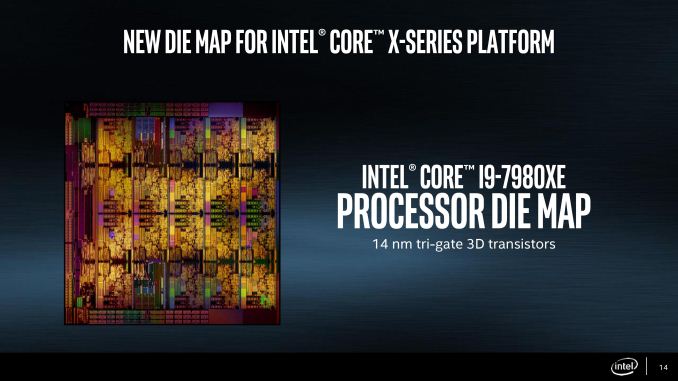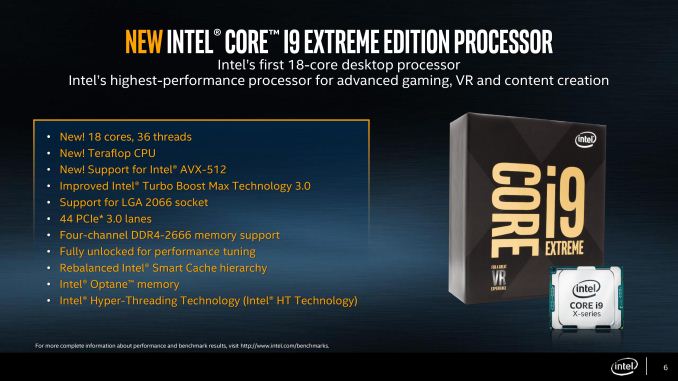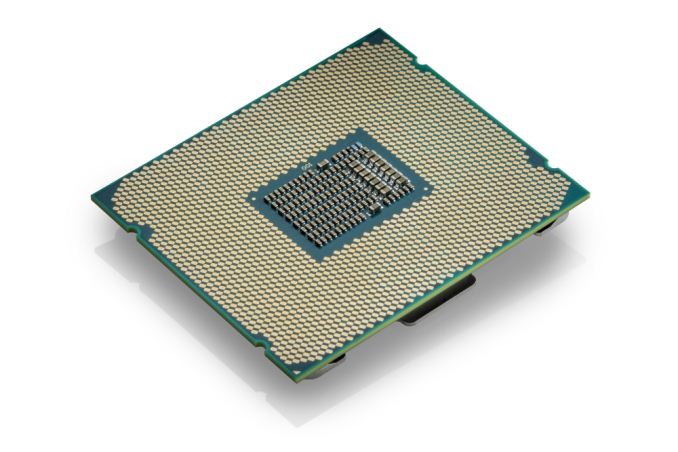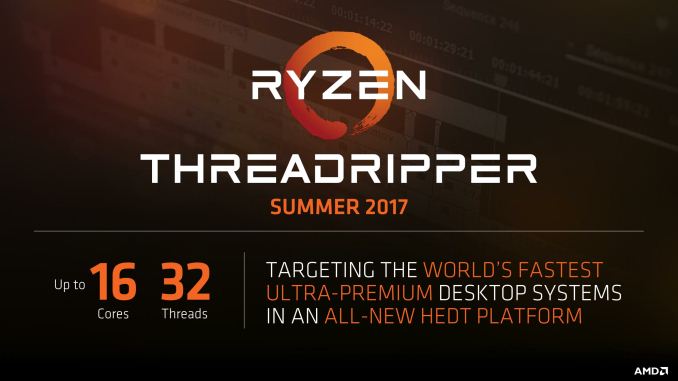Intel Announces Skylake-X: Bringing 18-Core HCC Silicon to Consumers for $1999
by Ian Cutress on May 30, 2017 3:03 AM ESTAnnouncement Two: High Core Count Skylake-X Processors
The twist in the story of this launch comes with the next batch of processors. In our pre-briefing came something unexpected: Intel is bringing the high core count silicon from the enterprise side down to consumers. I’ll cover the parts and then discuss why this is happening.
The HCC die for Skylake is set to be either 18 or 20 cores. I say or, because there’s a small issue with what we had originally thought. If you had asked me six months ago, I would have said that the upcoming HCC core, based on some information I had and a few sources, would be an 18-core design. As with other HCC designs in previous years, while the LCC design is a single ring bus around all the cores, the HCC design would offer a dual ring bus, potentially lopsided, but designed to have an average L3 cache latency with so many cores without being a big racetrack (insert joke about Honda race engines). Despite this, Intel shared a die image of the upcoming HCC implementation, as in this slide:
It is clear that there are repeated segments: four rows of five, indicating the presence of a dual ring bus arrangement. A quick glance might suggest a 20 core design, but if we look at the top and bottom segments of the second column from the left: these cores are designed slightly differently. Are these actual cores? Are they different because they support AVX-512 (a topic discussed later), or are they non-cores, providing die area for something else? So is this an 18-core silicon die or a 20-core silicon die? We’ve asked Intel for clarification, but we were told to await more information when the processor is launched. Answers on a tweet @IanCutress, please.
So with the image of the silicon out of the way, here are the three parts that Intel is planning to launch. As before, all processors support hyperthreading.
| Skylake-X Processors (High Core Count Chips) | |||
| Core i9-7940X | Core i9-7960X | Core i9-7980XE | |
| Cores/ Threads |
14/28 | 16/32 | 18/36 |
| Clocks | TBD | ||
| L3 | TBD | ||
| PCIe Lanes | TBD (Likely 44) |
||
| Memory Freq | TBD | ||
| TDP | TBD | ||
| Price | $1399 | $1699 | $1999 |
As before, let us start from the bottom of the HCC processors. The Core i9-7940X will be a harvested HCC die, featuring fourteen cores, running in the same LGA2066 socket, and will have a tray price of $1399, mimicking the $100/core strategy as before, but likely being around $1449-$1479 at retail. No numbers have been provided for frequencies, turbo, power, DRAM or PCIe lanes, although we would expect DDR4-2666 support and 44 PCIe lanes, given that it is a member of the Core i9 family.
Next up is the Core i9-7960X, which is perhaps the name we would have expected from the high-end LCC processor. As with the 14-core part, we have almost no information except the cores (sixteen for the 7960X), the socket (LGA2066) and the price: $1699 tray ($1779 retail?). Reiterating, we would expect this to support at least DDR4-2666 memory and 44 PCIe lanes, but unsure on the frequencies.
The Core i9-7980XE sits atop of the stack as the halo part, looking down on all those beneath it. Like an unruly dictator, it gives nothing away: all we have is the core count at eighteen, the fact that it will sit in the LGA2066 socket, and the tray price at a rather cool $1999 (~$2099 retail). When this processor will hit the market, no-one really knows at this point. I suspect even Intel doesn’t know.
Analysis: Why Offer HCC Processors Now?
The next statement shouldn’t be controversial, but some will see it this way: AMD and ThreadRipper.
ThreadRipper is AMD’s ‘super high-end desktop’ processor, going above the eight cores of the Ryzen 7 parts with a full sixteen cores of their high-end microarchitecture. Where Ryzen 7 competed against Broadwell-E, ThreadRipper has no direct competition, unless we look at the enterprise segment.
Just to be clear, Skylake-X as a whole is not a response to ThreadRipper. Skylake-X, as far as we understand, was expected to be LCC only: up to 12 cores and sitting happy. Compared to AMD’s Ryzen 7 processors, Intel’s Broadwell-E had an advantage in the number of cores, the size of the cache, the instructions per clock, and enjoyed high margins as a result. Intel had the best, and could charge more. (Whether you thought paying $1721 for a 10-core BDW-E made sense compared to a $499 8-core Ryzen with fewer PCIe lanes, is something you voted on with your wallet). Pretty much everyone in the industry, at least the ones I talk to, expected more of the same. Intel could launch the LCC version of Skylake-X, move up to 12-cores, keep similar pricing and reap the rewards.
When AMD announced ThreadRipper at the AMD Financial Analyst Day in early May, I fully suspect that the Intel machine went into overdrive (if not before). If AMD had a 16-core part in the ecosystem, even at a lower 5-15% IPC to Intel, it would be likely that Intel with 12-cores might not be the halo product anymore. Other factors come into play of course, as we don’t know all the details of ThreadRipper such frequencies, or the fact that Intel has a much wider ecosystem of partners than AMD. But Intel sells A LOT of its top-end HEDT processor. I wouldn’t be surprised if the 10-core $1721 part was the bestselling Broadwell-E processor. So if AMD took that crown, Intel would lose a position it has held for a decade.
So imagine the Intel machine going into overdrive. What would be going through their heads? Competing in performance-per-dollar? Pushing frequencies? Back in the days of the frequency race, you could just slap a new TDP on a processor and just bin harder. In the core count race, you actually need physical cores to provide that performance, if you don’t have 33%+ IPC difference. I suspect the only way in order to provide a product in the same vein was to bring the HCC silicon to consumers.
Of course, I would suspect that inside Intel there was push back. The HCC (and XCC) silicon is the bread and butter of the company’s server line. By offering it to consumers, there is a chance that the business Intel normally gets from small and medium businesses, or those that buy single or double-digit numbers of systems, might decide to save a lot of money by going the consumer route. There would be no feasible way for Intel to sell HCC-based processors to end-users at enterprise pricing and expect everyone to be happy.
Knowing what we know about working with Intel for many years, I suspect that the HCC was the most viable option. They could still sell a premium part, and sell lots of them, but the revenue would shift from enterprise to consumer. It would also knock back any threat from AMD if the ecosystem comes into play as well.
As it stands, Intel has two processors lined up to take on ThreadRipper: the sixteen-core Core i9-7960X at $1699, and the eighteen-core Core i9-7980XE at $1999. A ThreadRipper design is two eight-core Zeppelin silicon designs in the same package – a single Zeppelin has a TDP of 95W at 3.6 GHz to 4.0 GHz, so two Zeppelin dies together could have a TDP of 190W at 3.6 GHz to 4.0 GHz, though we know that AMD’s top silicon is binned heavy, so it could easily come down to 140W at 3.2-3.6 GHz. This means that Intel is going to have to compete with those sorts of numbers in mind: if AMD brings ThreadRipper out to play at around 140W at 3.2 GHz, then the two Core i9s I listed have to be there as well. Typically Intel doesn’t clock all the HCC processors that high, unless they are the super-high end workstation designs.
So despite an IPC advantage and an efficiency advantage in the Skylake design, Intel has to ply on the buttons here. Another unknown is AMD’s pricing. What would happen if ThreadRipper comes out at $999-$1099?
But I ask our readers this:
Do you think Intel would be launching consumer grade HCC designs for HEDT if ThreadRipper didn’t exist?
For what it is worth, kudos all around. AMD for shaking things up, and Intel for upping the game. This is what we’ve missed in consumer processor technology for a number of years.
(To be fair, I predicted AMD’s 8-core to be $699 or so. To see one launched at $329 was a nice surprise).
I’ll add another word that is worth thinking about. AMD’s ThreadRipper uses a dual Zeppelin silicon, with each Zeppelin having two CCXes of four cores apiece. As observed in Ryzen, the cache-to-cache latency when a core needs data in other parts of the cache is not consistent. With Intel’s HCC silicon designs, if they are implementing a dual-ring bus design, also have similar issues due to the way that cores are grouped. For users that have heard of NUMA (non-unified memory access), it is a tricky thing to code for and even trickier to code well for, but all the software that supports NUMA is typically enterprise grade. With both of these designs coming into consumer, and next-to-zero NUMA code for consumer applications (including games), there might be a learning period in performance. Either that or we will see software pinning itself to particular groups of cores in order to evade the issue entirely.














203 Comments
View All Comments
WorldWithoutMadness - Tuesday, May 30, 2017 - link
18C/36T. Soon, AMD'll revise threadripper up to 20C/40T and we'd have two giant fighting of +1/+2 of each others.SunLord - Tuesday, May 30, 2017 - link
AMD can probably move to 32C/64T at any time they please as Threadripper uses the same socket as the Naples/Epyc server cpu the biggest limiter would be motherboards as they are designed to limits AMD imposed on the Threadripper system such as quad channel and 44 pcie so AMD would have to do some tweaking to make it work with those limiters.tuxfool - Tuesday, May 30, 2017 - link
AFAIK, it isn't the same socket. Threadripper uses SP3r2 whereas Epyc uses R3 sockets.Samus - Tuesday, May 30, 2017 - link
Much like Intel's HEDT CPU's use a different socket (2011 opposed to 1151) so it makes sense to have a different socket especially if more PCIe lanes are being introduced.Thank you AMD for making Intel interesting again. LOL.
ddriver - Thursday, June 1, 2017 - link
The difference is that unlike intel, amd is not going to introduce a new and incompatible socket revision for every CPU revision.Obviously, the increased number of i\o requires a new socket, so you are going to have one for mainstream, one for hedt and one for server, that is pretty much inevitable. What is achievable is socket longevity, an aspect in which intel deliberately sucks big time.
JKflipflop98 - Saturday, June 3, 2017 - link
You know, I see AMD fanboys all over the internet use this same line and it just befuddles me. Why on Earth do you even care about socket compatibilities? Why would you EVER buy a brand new CPU, then immediately castrate its performance across the board by shoving it into some old and outdated motherboard? If you're really that strapped for cash, why are you spending money on PC upgrades?ddriver - Sunday, June 4, 2017 - link
It is because you are technologically ignorant. Motherboards do not bottleneck CPUs. Even memory controllers are now integrated in the CPU, so how fast your memory is depends on the CPU, the mobo only provides the slot to plug it into.Intel is not deliberately rendering sockets obsolete to maximize performance, but to force people to purchase more mobos, thus more chipsets from them.
A good mobo can be 300-500+$ investment. That's a significant amount of money to save. It can enable to you get substantially faster CPU or GPU for that saved money.
JKflipflop98 - Thursday, June 8, 2017 - link
Amazing how many people here are completely clueless how electronics actually work. Thanks for providing an example there, ddriver. Your moronic posts never cease to entertain.cpupro - Sunday, June 18, 2017 - link
@JKflipflop98Explain why owners of original high-end expensive Intel motherboards, I think it was X99 chipset, were required to buy new motherborad while third-party motherboard manufacturers required only BIOS update to support new revision of Intel CPU for same socket?
TheinsanegamerN - Monday, June 5, 2017 - link
"old and outdated" doesnt really apply anymore. The only difference between my p8z77 v-pro and a brand new mobo is the number of USB 3 ports. other than that, it does everything I need it to.It isnt the 90s when mobo designs were leaping ahead.